Advertisement
A Pacific Northwest boater learns everything the hard way about sailing, DIY, and making a dream come true.
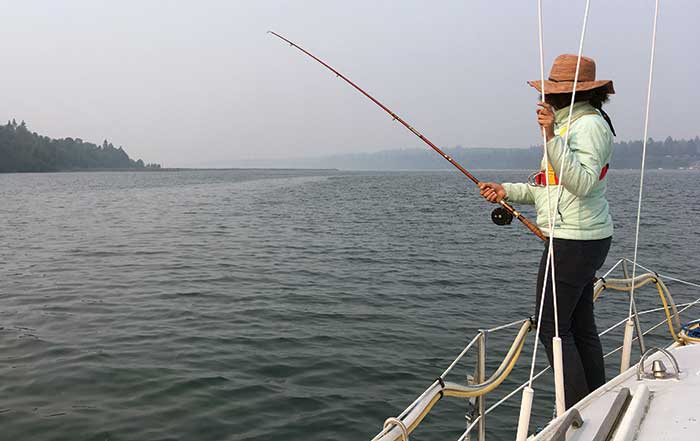
Sarah fishes en route to Hood Canal for a two-week vacation in 2018.
It was the 2013 documentary film "Maidentrip" that first kindled my imagination. It chronicled the true story of a 14-year-old Dutch girl named Laura Dekker who solo sailed a 38-foot two-masted ketch around the world. At the time, I was a 31-year-old waitress with a new master's degree in creative writing. That film shook me into a different way of looking at life, a compelling one immersed in the natural world, exploring far-off places, being self-sufficient, enjoying solitude.
I'd grown up in a happy family but was never encouraged to travel alone or to become handy with tools. I'd never set foot on a boat. Until seeing the movie, my impression of "yachting" was so clichéd that I didn't realize there was a place for someone like me.
I decided it was time to finally push back on my own self-imposed limitations. I impulsively withdrew my $8,000 savings, bought an old Catalina 27 named Papillon, and hoped she would teach me how boats worked. Did she ever!
The Drama Begins
The honeymoon period was brief. I quickly discovered that the surveyor missed a major issue — the aluminum fuel tank glassed in under the quarter berth was cracked and bypassed to an orange plastic tank in the stern lazarette. My first project was figuring out how to cut that old tank out piece by piece. In addition, the Vetus flexible water bladder was disgusting and needed replacement. And then there was that gross smell in the cabin that took two years to isolate, eventually revealing its origin to be cheap vinyl hoses in the head. I replaced every one myself.
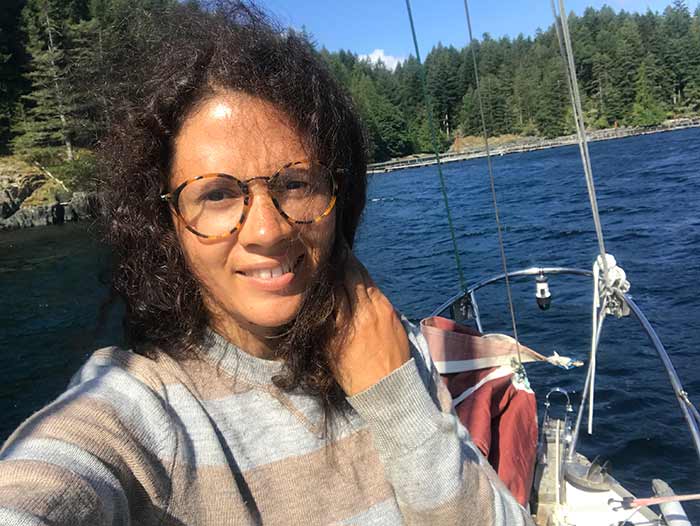
Sarah takes a selfie while stranded near a lee shore, 200 miles from home.
But not everything was bad. The best thing about Papillon was the Yanmar 2GM20F with fewer than 300 hours. In three years, it gave me little trouble.
Learning To Sail
After enrolling in Keelboat 101 and getting a docking lesson from a friend, my first solo trip was across Puget Sound, 5 miles from Shilshole Bay Marina in Seattle, Washington, to Port Madison's public dock on Bainbridge Island, and a pizza place that was my reward. Next, I singlehanded 12 thrilling miles to Poulsbo. I know it sounds corny because it wasn't far, but I was so happy that I bought postcards for people.
When I singlehanded to Blake Island, I'd stocked up on a feast of sushi rolls, chicken katsu, and frozen purple steamed buns stuffed with yam. I turned on the Sunny Life retro MP3 player and radio I'd picked up in Poulsbo, and blasted Rasputina, a little-known, niche cello goth rock band. My trip, my peculiar tastes!
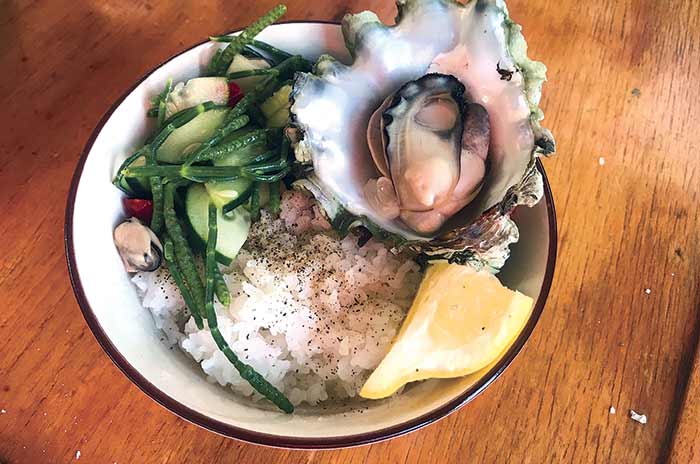
A delicious meal of foraged oysters, mussels, and sea beans during a trip to Hood Canal.
But I didn't only singlehand. Sometimes my partner, Harriet, came along and opened my eyes to new things I wouldn't have seen or done alone. When we returned to Blake Island, she researched clamming and geoduck hunting on that beach. We dug a pile of delicious giant razor clams and steamed them in beer. When we took a trip to the Hood Canal, we picked oysters on a beach where it was allowed, and steamed them on the boat using the Hitachi Chime-o-Matic steamer I'd picked up at Value Village for a buck. This was the life!
A Change Of Course?
I'd put so much work into Papillon, but I'd come to a crossroads. She'd taught me a lot but I realized I wanted more of a bluewater boat. Too bad this dawned on me just as the local canvas company finished up a full winter cover for her — my biggest financial regret in the three years I owned her.
While looking at boats, I took a cashier job at a Seattle-based boating supply retailer, Fisheries Supply, where I learned so much about boating and got a fantastic employee discount. After some time, I aspired to a promotion into the sailboat department where there was opportunity to build my expertise. I also had a second job on a domestic violence helpline 24 hours per week. It was minimum wage, but both jobs gave me enough to pay my bills.
When I bought Tortuga, my 1969 Rawson 30, I paid off the $8,000 purchase price over nine months. Around the same time, I got that promotion to the sailboat department. During slow winter months, I spent time at work reading product manuals and learning how everything in the department worked: windlasses, anchor types, the construction of different ropes. I requested summer 2019 off, a year and a half in advance, with a goal to singlehand Tortuga around Vancouver Island, a voyage of about 45 days. I even approached the vice president of Fisheries to ask if he'd consider sponsoring me to become the first Black woman to sail around the world alone. He said if I singlehanded around Vancouver first, they'd do it!
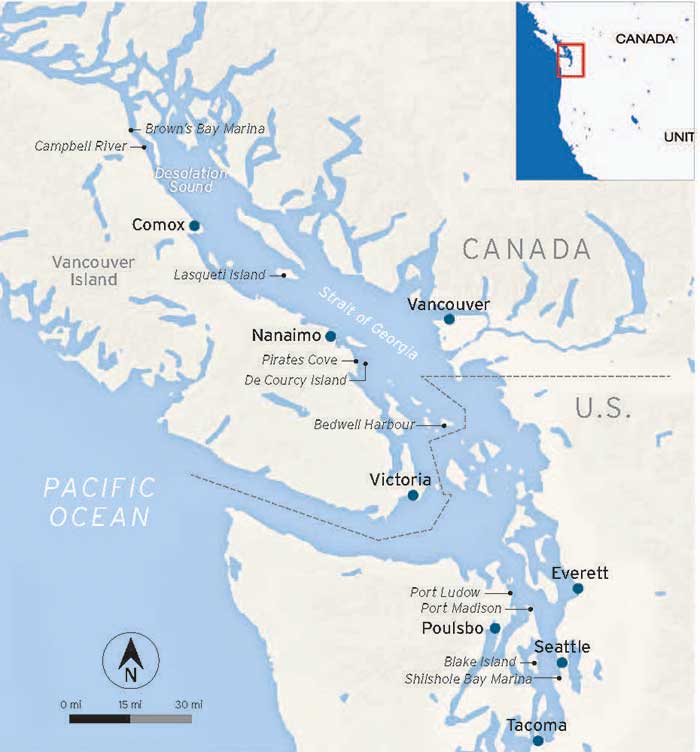
Boat Work With A Goal
I spent that year-and-a-half working on Tortuga, preparing her for the journey. Wearing coveralls and a respirator, I re-cored the wet bow under the windlass — from underneath — using Coosa Board, a composite wood substitute that doesn't rot or absorb water. I also rewired the boat and mast from scratch, which took several months.
In retrospect, the Rawson wasn't worth what I paid for it, and the Catalina was worth more than I sold it for. But there was a silver lining: The sale introduced me to Meredith, a hard-working diesel mechanic who quickly became a good friend and guided me through all the work needed to overhaul Tortuga's rusty, worn-out Volvo 2002 that was approaching four decades old.
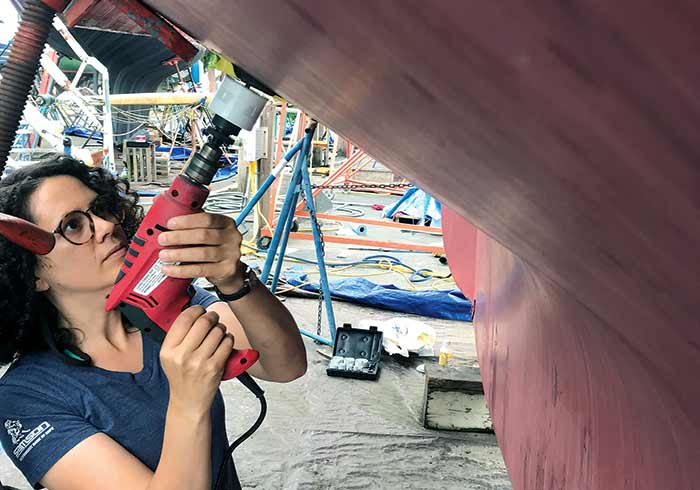
Sarah drills a hole for a new thru-hull transducer.
Out in the freezing cold in my Carhartts, snow or shine, I replaced all the hoses and accessories and built a new gauge panel from scratch, complete with a harness and five-pin relay I wired myself. I certainly made mistakes along the way, like mixing up two relay pins that fried my starter, and not having a diode installed to enable the alternator to charge the battery. Eventually I fixed it all.
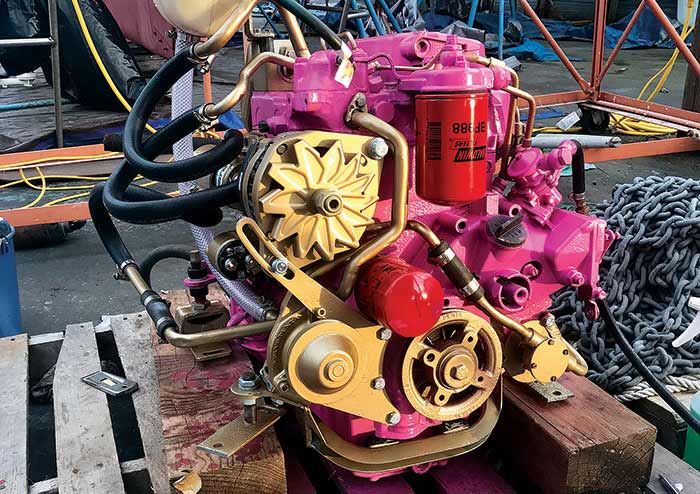
The overhaul on Tortuga's worn-out engine included a coat of pink and gold paint.
After the rebuilt engine was lifted into the boat with a crane, I accidentally drilled a hole through the boat while trying to mount the engine and had to get the boat hauled again. Finally, she splashed, and the alignment took me 12 hours using a feeler gauge and hammer to tap it slightly side to side. Meredith checked and said I'd actually gotten it down beyond the required .003 to .0015 inches!
And She's Off!
In the days leading up to my departure, my friends and I, along with the South Park Marina staff, worked round-the-clock, except for our jobs and a bare minimum of sleep, to get Tortuga rigged. Harriet installed most of the deck hardware including jacklines. Finally, the bridges of the Duwamish parted, and I was free! I couldn't stop grinning as darkness set in and Tortuga slipped under the West Seattle Bridge. Fisheries and Vesper had given me an AIS Watchmate 850 so I could be alerted to tugs and cargo ships. My goal for that night was Port Madison, 15 miles away, which I reached around 10 p.m.
The next morning, I motored to Port Ludlow, then traveled 60 miles the next day, solo, across the Strait of Juan de Fuca. This trip had been a goal for so long. My only concern was the engine, which got smoky in warm weather or when I went above 5 knots. So I kept it in a lower gear.
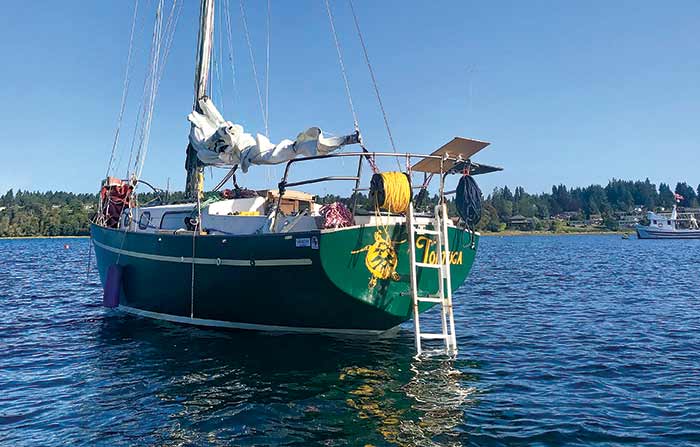
Tortuga anchored in Bedwell Harbour in British Columbia's Gulf Islands.
Anchored in Bedwell Harbour in the Gulf Islands, I headed to the steam cave at Susurrus Spa, the first time I'd relaxed in forever. Then it was on to Pirates Cove Marine Provincial Park, which was so shallow I ran aground near low tide. Luckily some nice powerboaters tipped my boat by the halyards just in time to help me escape.
In Nanaimo I visited the chandlery, went to a pub, ate some celebratory ice cream, and bought some of the famed Nanaimo bars for friends and family, as promised. In the Strait of Georgia, the wind gave Tortuga a good sail at last, a relief, as by now the engine was giving me constant trouble. I anchored overnight behind Lasqueti Island, the mosquito capitol of the universe, and all night watched my anchor and proximity to a neighboring boat that had anchored close, nervous that if I needed the engine, it would fail me.
The next morning, I hightailed it to Comox, dinghied to the marina, walked to town, and devoured sushi for the first time on my trip. When the woman at Sound Marine chandlery heard that I was sailing around Vancouver by myself, she surprised me by selling me a new VHF at cost! Everyone I encountered on this journey was so nice
Engine Blues
Motoring up to Campbell River, I timed my entry to Seymour Narrows. Even at slack tide, the currents tugged Tortuga every which way, but we chugged though and anchored in Deepwater Bay. Before I could strategize my trip through Johnstone Strait, the engine died for good. I discovered water back-flooding the engine because the flywheel had become hydrolocked. It was my own fault: I'd installed my exhaust thru-hull too high on the hull with no waterlock muffler.
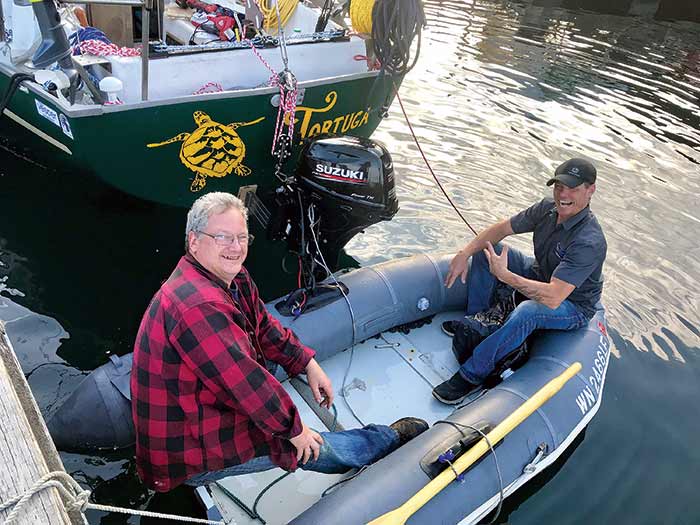
Locals at Brown's Bay helped mount the new 20-hp Suzuki outboard on Tortuga so Sarah could get home.
The Canadian Coast Guard towed me across Discovery Passage to Brown's Bay Marina. Disappointed, I ordered a new Suzuki outboard. I spent two weeks eating my way through the menu of The Narrows Floating Restaurant until Harriet picked up the outboard in Port Alberni and brought all the mounting hardware from Fisheries Supply. Even so, I knew I couldn't make the full route before I had to be back at work, and had to accept the fact that my dream would have to wait.
Tip
With local help, I got the outboard installed and was off, back through Seymour Narrows and to Comox, where the weather turned stormy. The only weather window was to go overnight in the Strait of Georgia. To be honest, I was afraid. But I was also pulled toward doing it because it was badass and because I craved a win after the disappointment of my engine problems blowing my chances of completing the Vancouver circle. By now, though, I'd learned the hard way that you have to be careful and smart to earn the title of badass, or it's easy to earn the title of fool.
Although my amazing friends at Fisheries Supply had gifted me a Garmin InReach for satellite communication and an EPIRB for emergencies, I couldn't access weather apps, so my mom texted me the forecast using the InReach. The person who is the most obsessed with your safety can become a weather expert fast! I left at 1 a.m., as she instructed, and motored behind Denman Island to avoid the southeast waves that caused my outboard prop to come out of the water.
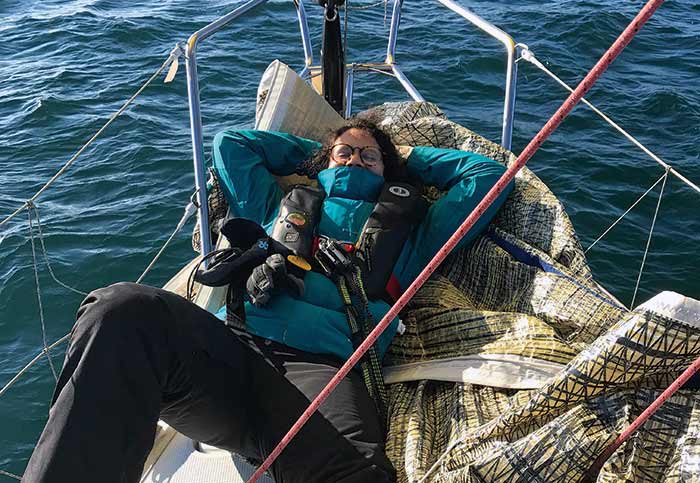
Sarah takes a break from bow work during the Round the County race. (Photo: Nick Marson)
It was beautiful. Your sense of solitude is heightened when the land sleeps as you pass by in the dark coolness while looking up at the stars. Tortuga glided over the cable ferry lines behind the island, and a few hours later emerged into the open strait. There was a good swell, so I angled the boat to keep the prop submerged. In the middle of the strait, at 4 a.m., I was swallowed by fog. Thank goodness for that AIS! Sailing blind, I was going by the Navionics on my cellphone and the compass on my AIS to ensure Tortuga was still on track.
I covered more than 100 miles in the next 24 hours with a quick pitstop in Nanaimo for fuel, then back underway to make slack tide at Dodd Narrows. Trincomali Channel, on the west side of De Courcy Island, was rough and choppy. I beat into it, worried about overtaxing the outboard, then ducked into Pirates Cove, which was glassy and peaceful, with birds soaring and cawing — a different world. This time, I knew where to anchor, made dinner, and went to sleep. When I reached Seattle, Harriet was waiting at my slip. It had been 400 miles, 39 days, and probably the proudest day of my life.
Then, Life Happens
For a while, I planned to repower the boat with a new Beta engine before trying again, but I no longer had time for a big project boat and wasn't in love with Tortuga's design or cabin layout. I got promoted to assistant store manager, a job I love. Finally, I saved enough to buy a boat that seemed perfect for me. I snapped up a 1976 Hallberg-Rassy Monsun 31, which is in great shape with a newer Universal M25XPB engine. I renamed her Beverly after Dr. Beverly Crusher from "Star Trek, The Next Generation." The boat is elegant and classy, just like she is. My sailing odyssey began seven years ago, randomly inspired by a movie about a teenager's accomplishment. That changed my life and gave me a profession and a boating community I love.
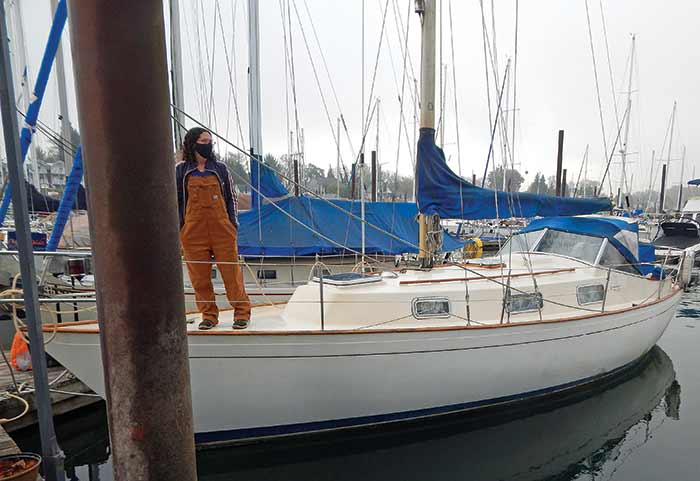
Sarah is preparing her latest boat, Beverly, a 1976 Hallberg-Rassy Monsun 31, for another attempt at singlehanding around Vancouver Island this summer. (Photo: Pat Devlin)
I still hold tight to my solo sailing ambitions, but I have learned two crucial lessons along the way: First, nobody accomplishes anything in life solo. It takes a community and hard work. Second, the destination is nowhere near as important as the journey itself, and the relationships that we make along the way.
